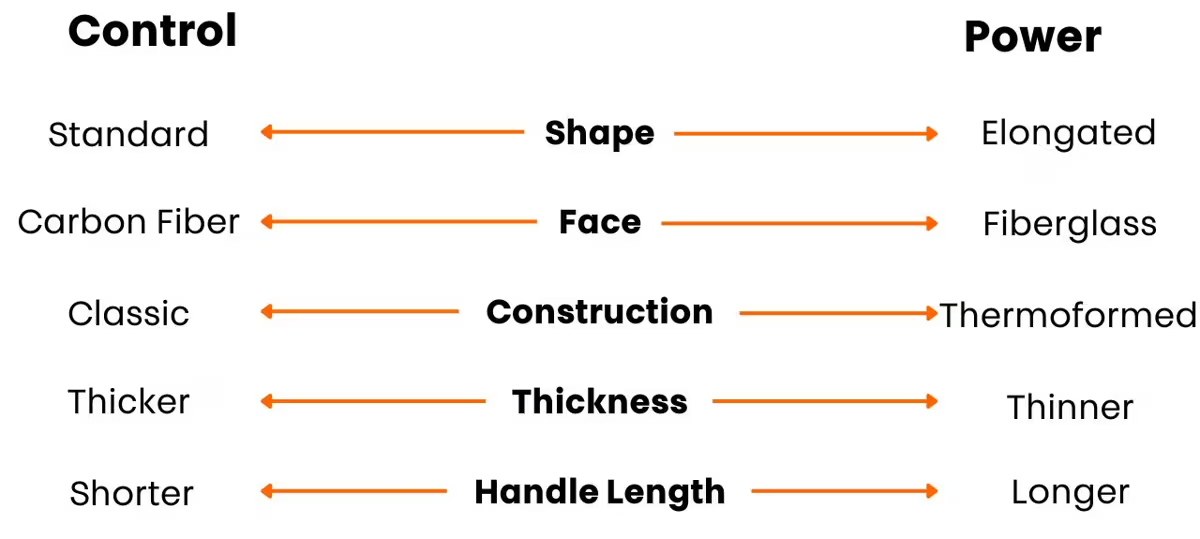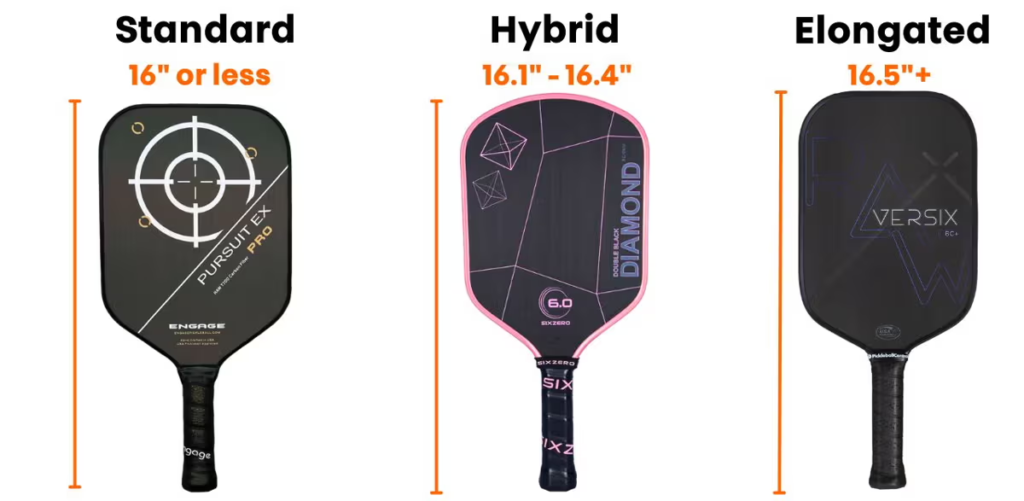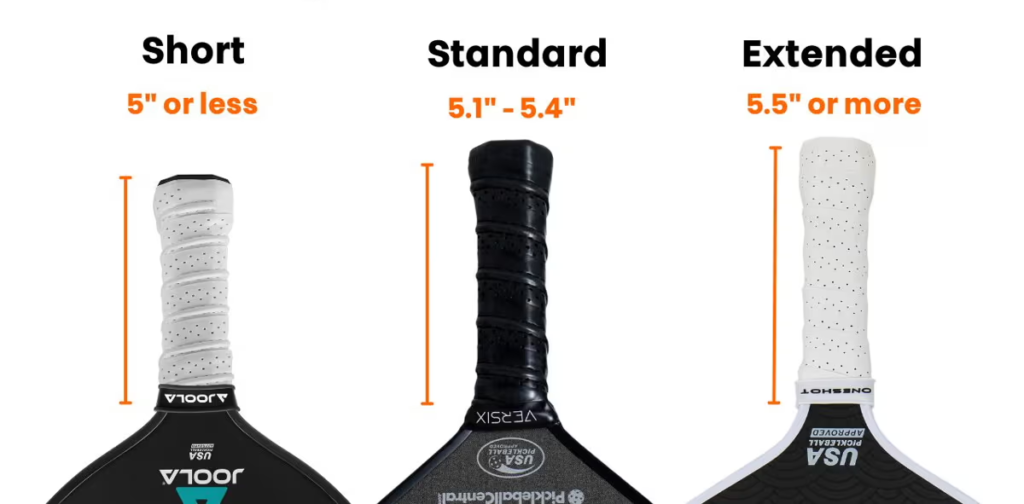Choosing a good pickleball paddle can feel overwhelming, but there’s no need to worry. At Best Paddles, our experts have created this “paddle guide” to help you find a paddle that matches your unique preferences and playing style.
In this guide, we cover the 5 most important factors to consider when choosing the right pickleball paddle:
- TYPE
- SHAPE
- GRIP
- WEIHT
- SPIN
Table of Contents
Pickleball Paddle Type
Control vs Power
Every player is unique, and to suit various playstyles, paddles come in different types. The main distinction between paddles is the balance of power and control they offer. Below, you can learn about each type to determine which will best suit you on your pickleball journey.

Control Pickleball Paddles
Control or “touch” paddles have a large, consistent sweet spot that helps players place the ball more accurately. These paddles “slow the game down” by absorbing more energy and reducing the pace of opponents’ shots. However, the limited power can make it challenging to create pressure through aggressive offense.
Power Pickleball Paddles
Power paddles make it easy to hit with pace, allowing players with shorter, more compact swings to generate additional speed. Players who already hit the ball hard may appreciate the “extra boost” from power paddles. However, these paddles require precision and discipline to keep the ball within the lines. Therefore, beginners might want to start with a more forgiving paddle.
Pickleball Paddle Thickness
Paddles are available in various thicknesses, typically ranging from 8 to 20mm, and it is common to find the same paddle model offered in different thickness options. While there are general guidelines for selecting the appropriate paddle thickness for your game, it’s essential to remember that exceptions can apply.

Thinner
Thinner paddles generally offer more “pop” or rebound, which is why many manufacturers label their thinner options as “power paddles.” These paddles often have a smaller sweet spot, making them harder to control if players cannot consistently hit it. As a result, they are more commonly chosen by advanced players.
Thicker
Thicker paddles tend to distribute force more evenly, making it easier to control the ball. They feature a more consistent sweet spot across the face and offer slightly less rebound, resulting in more predictable shots. Players seeking more forgiveness or aiming to improve their game often opt for a paddle with a thicker core.
Pickleball Paddle Shape
According to the rules, pickleball paddles cannot exceed 17 inches in length. Additionally, the combined length and height must not exceed 24 inches. To stand out and maximize the paddle’s “sweet spot,” manufacturers have developed various shapes that fit within these dimensions. Generally, there are three main shapes available on the market today:

Standard
✓ Great for beginners
✓ Improves hand speed
✓ Most forgiveness
✘ Limited reach
✘ Lower power potential
Hybrid
✓ Best of both worlds
✓ Moderate power
✓ Good hand speed
✘ Fewer options
✘ Not “the best” at any one thing
Elongated
✓ Most power potential
✓ Great for tennis players
✓ Maximixes reach
✘ Slower hand speed
✘ Smaller sweet spot
Standard: Modeled after the original pickleball paddles, standard shapes offer the widest sweet spot and are typically more maneuverable than longer paddles. Standard-shaped paddles are excellent for beginners, but many professional players on the PPA Tour choose this shape for its quick hand speed and sharper reaction times.
Hybrid: Growing in popularity lately is the hybrid shape that fits between the elongated and standard and carries benefits from each. While a fantastic choice for many, the differences between this and the shapes around it are small, and you do limit your options by narrowing down to this shape alone.
Elongated: Elongated paddles extend the face, adding reach and power potential by positioning the sweet spot further from your hand. These paddles are most commonly used by PPA Tour professionals, former tennis or racquet sports players, and those who need extra reach.
Pickleball Paddle Grip
Handle Length
Depending on their playstyle, some players prefer different handle lengths. While most players are comfortable with a standard handle, there are reasons why someone might choose a shorter or extended option.

Short
✓ Great for players with one-handed backhands
✓ Maximizes face for fewer mis-hits
✓ Most maneuverable
Standard
✓ Enough room for most players to squeeze in a second hand
✓ Balances power and maneuverability
✓ Most versatile
Extended
✓ Great for players with two-handed backhands
✓ Pushes balance higher for more power on full swings
✓ Most leverage for power
Grip Circumference
While most players won’t have an issue with grip circumference regardless of the paddle they choose, those with very small or large hands should consider a few factors when finding their perfect paddle.

✓ You can always add overgrips to increase grip size, there is very little you can do to decrease it
✓ Smaller grips also allow your wrist to play a more active role, but too small can cause elbow issues
✓ Most players will be fine using anything in the small and medium categories
Pickleball Paddle Weight
One of the biggest indicators of whether a paddle is right for you is its weight. If a paddle is too light, you won’t unlock your full power potential or benefit from the added stability that more weight provides. Conversely, if it’s too heavy, you might be slow to get your paddle in position and could even experience issues like pickleball elbow. The chart below provides context for paddle weight ranges to help you make the best decision for your game.
Static Weight
Static weight refers to the weight of a paddle when placed on a scale. It serves as a useful starting point for choosing a paddle that suits your game. Paddles with lower weights are generally more maneuverable, while those with higher weights tend to offer greater stability and power.
| Static Weight Ranges (oz.) | Performance |
| Ultra Light: < 7.4 | Rare weight range in today’s market. Extremely mobile,/easy to swing, but often lacking power and stability. |
| Light: 7.4-7.7 | Fantastic maneuverability/hand speed. Very easy to swing. |
| Mid-weight: 7.8-8.2 | Common weight range for performance paddles. Balance of mobility and power. |
| Heavy: > 8.2 | High-end performance paddles often fall in this range. Recommended for experienced players and very strong people. |